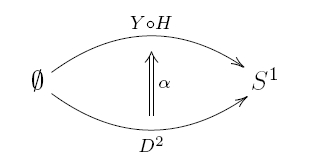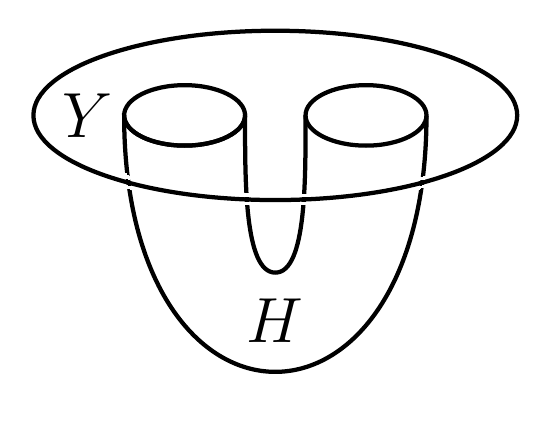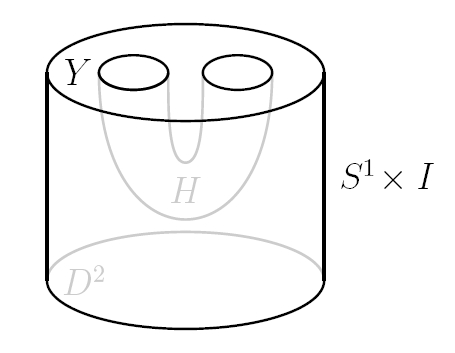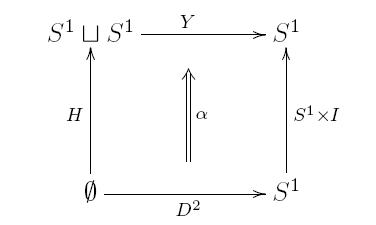Wormholes and Entanglement
Posted by John Baez
For the last couple years, people interested in quantum gravity have been arguing about the ‘firewall problem’. It’s a thought experiment involving black holes that claims to demonstrate an inconsistency in some widely held assumptions about how quantum mechanics and general relativity fit together. Everyone is either scratching their heads over it, struggling to find a way out… or grumbling that the problem isn’t real, and everyone else has gone crazy.
While the firewall problem has roots going back earlier, the paper that got everyone interested came out in July 2012:
- Ahmed Almheiri, Donald Marolf, Joseph Polchinski and James Sully, Black holes: complementarity or firewalls?
They called it the ‘firewall’ problem because one way out is to assume that when you fall into a black hole you hit a ‘wall of fire’ — a region of hot radiation — as you cross the event horizon. That sounds crazy: the equivalence principle says you shouldn’t feel anything special as you fall through the horizon, at least if the black hole is big enough. But they claimed this crazy-sounding solution was the most conservative way out!
In June of the following year, two extremely reputable physicists, in their attempts to avoid this conclusion, came up with an idea that sounds even crazier: every pair of entangled quantum particles is connected by a wormhole!
- Juan Maldacena and Leonard Susskind, Cool horizons for entangled black holes.
They called their proposal EPR = ER, which is a joke referring to two papers Einstein wrote in 1935. EPR stands for ‘Einstein–Podolsky–Rosen’, the authors of a famous paper on quantum entanglement, a spooky way that distant objects can be correlated. ER stands for ‘Einstein–Rosen’, the authors of a famous paper on wormholes, solutions of general relativity in which distant regions of space can be connected by a kind of tunnel, or handle.
I haven’t been thinking much about quantum gravity lately, but the recent convulsions in my old favorite subject caught my attention. In particular, I’d long been fond of the idea that when we finally understand quantum gravity, the distinction between quantum mechanics and our theory of spacetime will evaporate. There’s a lot of evidence coming from category theory, which reveals analogies between the two:
Now, quantum entanglement is a sneaky way for two distant particles to be correlated. A wormhole is a sneaky way for two distant particles to be connected. Could this be hinting at yet another analogy between quantum mechanics and our theory of spacetime? Perhaps one that deserves a category-theoretic treatment?
Last summer, when Jamie Vicary and I were both at the Centre for Quantum Technologies, we figured out something interesting about this. We wrote a paper about it, which is done now:
- John Baez and Jamie Vicary, Wormholes and entanglement.
I’d like to explain a bit of it here, because it uses 2-categories in a cute way.
Disclaimers
First, I want to emphasize that Jamie and I are not making any claims about the firewall problem. In particular, we’re not claiming that EPR = ER is a way to solve the firewall problem.
Second, we’re not claiming that in our universe, every quantum-entangled pair of particles is connected by a wormhole.
Third, I’m not going to explain the firewall problem here. I don’t feel I have a deep understanding of it — and in fact, I wouldn’t be shocked if it gently dissolves when people think about it carefully enough. So, if you want to get a feel for this problem, but don’t feel quite up to the technical literature, I recommend starting with these blog articles:
- George Musser, When you fall into a black hole, how long have you got?
- John Preskill, Is Alice burning? The black hole firewall controversy.
- Joe Polchinski, Black Holes, complementarity, and firewalls.
I’ve listed them in roughly increasing order of how much physics you need to know to enjoy them, but they’re all good in different ways. The quantum information theorist John Preskill also wrote a nice intro to Maldacena and Susskind’s work:
- John Preskill, Entanglement = wormholes.
Wormholes and pair creation
Okay, so let me tell you what I’m actually going to tell you about. Jamie and I did some calculations that work in a simplified setup where spacetime is just 3-dimensional, and nothing about spacetime matters except its topology. This is called a 3-dimensional topological quantum field theory, or 3d TQFT for short.
3d TQFTs are good for describing quantum gravity in a fictitious world where spacetime is 3-dimensional and time is no different from space. At a more practical level, they’re also good for describing thin films of certain special substances at very low temperatures! Some people want to use these films to make topological quantum computers.
Here’s the interesting thing: in this setup, the creation of a particle-antiparticle pair can be reinterpreted as the formation of a wormhole. The particle and its antiparticle are the opposite ends of the wormhole! See, we can interpret this picture two ways:

In one way of interpreting this picture, we’re looking at a chunk of spacetime with a curved tube removed. Reading it from bottom to top, space starts out as a disk and ends up as a disk with two holes. So, a particle-antiparticle pair is being created!
In the other way of interpreting this picture, we think of that curved thing as a wormhole: a handle connecting two distant part of space. Reading from bottom to top, space starts out as a disk and ends up as a disk with a handle attached. So, a wormhole is being formed!
If this seems confusing, don’t worry: I’ll explain it more precisely later.
The idea that particle-antiparticle pairs could be wormhole ends is an old one, going back to the paper by Einstein and Rosen. It’s especially cute for electrically charged particles. When it seems the electric field is diverging, coming out of a particle, maybe it’s really just flowing through a wormhole and coming out one end… and flowing in the other end, which would thus look like a particle of the opposite charge.
The idea has been kicking around for a long time. John Wheeler was especially fond of it: he called it ‘charge without charge’. But the discovery of 3d TQFTs gave us a context where we can make this idea precise and calculate with it.
This lets us relate quantum entanglement of particle-antiparticle pairs to wormholes. Indeed, we can compute what happens when a wormhole forms in a 3d TQFT, and use that to compute the state of the resulting particle-antiparticle pair.
The particle and antiparticle act entangled! They even act like they’re ‘completely’ entangled: every piece of information about the particle at one end of the wormhole is encoded in information about its antiparticle at the other end.
This entanglement is, however, a kind of sham. The particle and its antiparticle act entangled, but they have no choice about this, since they are not really separate things. They are just two views of the same thing: the wormhole. True entanglement arises when two independent things are correlated in a certain way. It doesn’t really count as entanglement when something is correlated with itself.
The fact that the entanglement is ‘fake’ was crucial for Maldacena and Susskind, who used it to get around a key aspect of the firewall problem: the so-called ‘monogamy of entanglement’. Just as it’s against the rules to be married to two people, a quantum system can’t be entangled with two others. But ‘fake’ entanglement isn’t monogamous.
Jamie Vicary and I make the concept of fake entanglement precise in our paper, but I don’t feel like talking about that now. Instead, I want to say more about how the creation of a particle-antiparticle pair can be reinterpreted as the formation of a wormhole. This is where 2-categories come in…
Wormholes and pair creation: the 2-categorical view
In our simplified setup where spacetime is just 3-dimensional, space is just 2-dimensional, and the formation of a wormhole looks like this:

This process goes from a disk to a disk with a handle attached. But the disk itself can be seen as a process going from the empty set to a circle… and so does the disk with a handle attached. A ‘process between processes’ is a 2-morphism in a 2-category. So, the formation of a wormhole is actually a 2-morphism, like this:

Here is the empty set, is the circle, and is the disk. is the disk with a handle attached… but why am I calling it that?
Here’s why. The disk with a handle attached can be chopped into two pieces: a handle, and a disk with two holes:

The handle goes from the empty set to the disjoint union of two circles:
The disk with two holes goes like this:
So, the disk with a handle is the composite
Okay, so we’ve sliced and diced the process of wormhole formation and seen how it’s a 2-morphism in a 2-category. What about the process of creating a particle-antiparticle pair? What does that look like?
It looks like this:

We read this from bottom to top. Space starts out as a disk. As time passes, a particle-antiparticle pair forms. When they’ve formed, space is a disk with two holes. (You see, in 3d TQFTs a particle can be treated as a hole cut out of space, or ‘puncture’.)
Here’s a 2-categorical diagram for this process of pair creation:

At the start, space is a disk — and as before, we think of this disk as going from the empty set to the circle:
As time passes, space turns into a disk with two holes, namely
As this happens, the circle doesn’t change, but the empty set turns into two circles, thanks to the handle
Now here’s the punchline. Take the square diagram:

Compose the left and top arrows, and compose the bottom and right ones. The bottom and right ones compose to give a disk:
so we get a diagram we’ve already seen:

This is the diagram for wormhole formation! So, pair creation is just wormhole formation in disguise.
2-categorical remarks
Finally, here are some remarks that may be too categorical, and even too 2-categorical, for most readers to enjoy.
The ‘bigon’ here is how we draw a morphism in a 2-category:

But the square here is how we draw a morphism in a double category:

There’s a standard trick for getting double categories from 2-categories, due to Ehresmann, and that’s what we’re using here. It’s fairly common for people to study TQFTs using 2-categories. Indeed, Jamie is writing a huge multi-part paper on this with Bruce Bartlett, Chris Douglas and Chris Schommer-Pries, which will be really exciting when it comes out, assuming hell hasn’t frozen over yet. It’s less common for people to study TQFTs using double categories, but Jeffrey Morton has:
- Jeffrey Morton, Extended TQFTs and quantum gravity.
- Jeffrey Morton, Double bicategories and double cospans.
The advantage of double categories is that they let us study cobordisms-between-cobordisms where the boundary of space changes with time… as in pair creation. Since Jeffrey was my grad student, I was primed to think about this issue.
Here’s another thing, which Jamie and I were reluctant to include in our paper. You can get a 3d TQFT from a modular tensor category , and then
Since a hole in space acts like a particle, and cutting out a hole in space leaves a circle as boundary, plays the role of the ‘2-Hilbert space of particle types’. has a basis of simple objects which are the various types of particles.
The 2-Hilbert space for a pair of particles is then
where is the tensor product of 2-Hilbert spaces. So when we apply our TQFT to a handle
we get
and this functor is determined by its value on , which is
where ranges over the simple objects of , and is the dual of .
Translating back into physics: the two ends of the wormholes act like particles. These particles can be of any type whatsoever, but if one end happens to be a particle of type , the other end has to be the corresponding antiparticle, . So, you could call the space of states of a particle-antiparticle pair.
And, this space of states is a categorified version of a completely entangled state! In ordinary quantum mechanics, we could have a Hilbert space with a basis , and a completely entangled state would be something like
(up to normalization). Now we’ve got a 2-Hilbert space and
It’s the same idea, one level up! We could call this ‘2-entanglement’.
Even better, we have a kind of microcosm principle thing going on. In higher category theory, little things often naturally live in bigger things that are categorified versions of themselves. For example, monoids naturally live in monoidal categories. There are many other examples, too. This is called the ‘microcosm principle’.
In the situation here, we’ve already seen the space of states of the particle-antiparticle pair is 2-entangled. But the formation of a wormhole creates an element of this space of states: a particle-antiparticle pair in a particular state. And this state is itself entangled!
Jamie explain this in more detail in our paper, starting at equation (4). But we didn’t mention that the entanglement of the state of the particle-antiparticle pair is ‘riding’ the 2-entanglement of the space of states of this pair. You have to really like higher categories to care about an observation like this.

Re: Wormholes and Entanglement
That’s a very cute paper! I wish I understood TQFTs better in order to really make sense of what’s going on. So here are some basic questions.
First, you write: “In the presence of topology change, the time evolution operators in a TQFT are not unitary, only linear”. I’ve noticed this before and it confused me. How am I supposed to think of this in terms of physics?
Second, the way in which the double category approach handles (no pun intended ;-)) space is such that space itself is a morphism in a category, having an ingoing and an outgoing boundary. Again, what does this mean physically? I can see that space may have a boundary, but why does it come in two parts?
I can see that both questions have to do with the fact that objects in cobordism categories have duals, but the physical meaning eludes me…